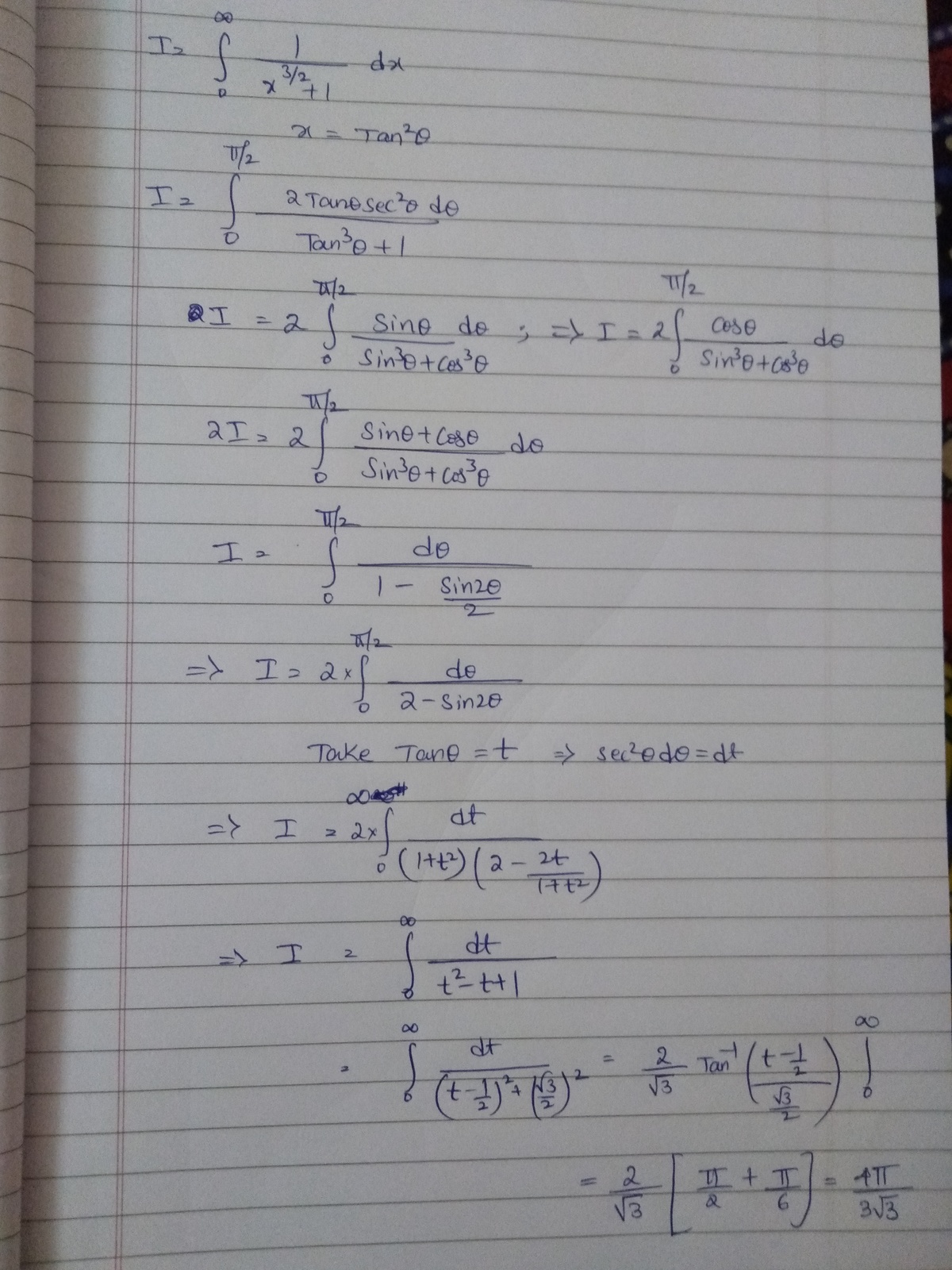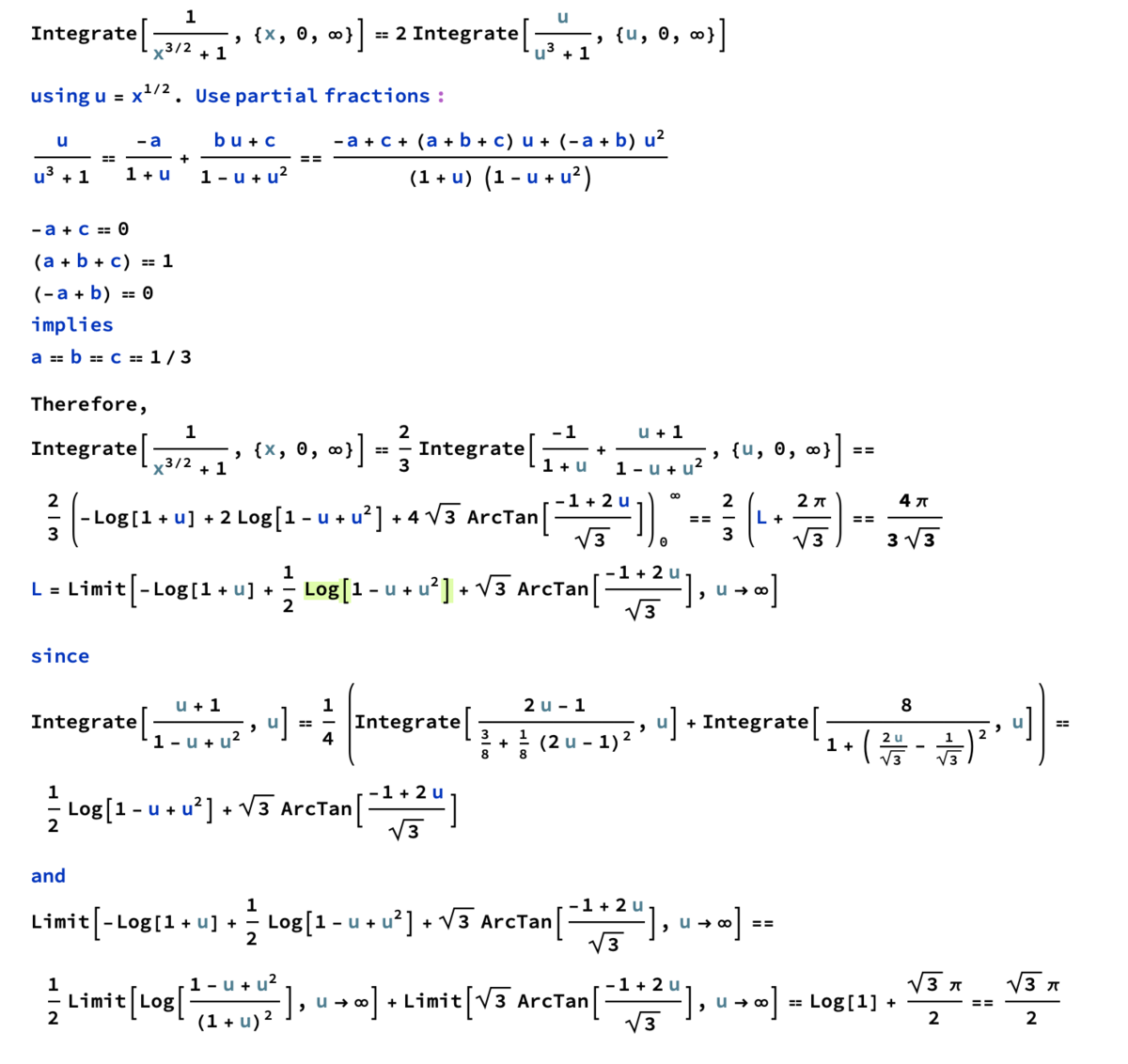Difficult integral #2
∫ 0 ∞ x 2 3 + 1 1 d x = b d c a π
The equation above holds true for coprime positive integers a , b , c , and d .
What is the minimum possible value of a + b + c + d ?
The answer is 12.
This section requires Javascript.
You are seeing this because something didn't load right. We suggest you, (a) try
refreshing the page, (b) enabling javascript if it is disabled on your browser and,
finally, (c)
loading the
non-javascript version of this page
. We're sorry about the hassle.
5 solutions
The subsitution u = x 2 3 gives ∫ 0 ∞ x 2 3 + 1 1 d x = 3 2 ∫ 0 ∞ u + 1 u − 3 1 d u = 3 2 B ( 3 1 , 3 2 ) = 3 2 Γ ( 3 1 ) Γ ( 3 2 ) = 3 2 × sin 3 1 π π = 3 3 4 π = 3 2 3 4 π making the answer 4 + 3 + 3 + 2 = 1 2 .
4 and 2 are not coprime though
Log in to reply
True, but 4 , 3 , 3 , 2 are coprime, since they have no common factor other than ± 1 . There is a difference between coprime and pairwise coprime .
My solution is based on Contour integral. First, we do a substitution u = x such that the integral becomes
I = ∫ 0 ∞ x 3 / 2 + 1 1 d x = ∫ 0 ∞ u 3 + 1 2 u d u
Let ρ be a very small positive number and R a very large positive number, ρ < R . Let C be the positively oriented contour consists of four parts: C = C 1 ∪ C 2 ∪ C 3 ∪ C 4 , where C 1 = { x ∈ R ∣ ρ ≤ x ≤ R } , C 2 = { R e i θ ∣ θ ∈ [ 0 , 2 π / 3 ] } , C 3 = { x e 2 π i / 3 ∣ ρ ≤ x ≤ R } , C 4 = { ρ e i θ ∣ θ ∈ [ 0 , 2 π / 3 ] } .
Since the function 2 u / ( u 3 + 1 ) only has one simple pole at u = e i π / 3 , by residue theorem, the contour integral is I C = ∫ C u 3 + 1 2 u d u = 2 π i u = e π i / 3 R e s u 3 + 1 2 u = 3 4 π e π i / 6 .
Taking ρ → 0 + and R → ∞ , the paths C 2 , C 4 converges to zero, hence I C = ∫ C 1 u 3 + 1 2 u d u − ∫ − C 3 u 3 + 1 2 u d u = ∫ 0 ∞ u 3 + 1 2 u d u − ∫ 0 ∞ u 3 + 1 2 e 2 π i / 3 u ⋅ e 2 π i / 3 d u (Crucial role of C 3 here) = ( 1 − e 4 π i / 3 ) I = 3 e π i / 6 I . Comparing two expression of I C we see I = 3 3 4 π .
$$ x=tan^{4/3} \theta$$ just makes it the same old cuberoot(tan) integral


Lets start by substituting x = u and finding the antiderivative The integral becomes ∫ 1 + u 3 2 u d u
Note that ( 1 + u ) ( 1 − u + u 2 ) = 1 + u 3 ,which gives the integral as ∫ ( 1 + u ) ( 1 − u + u 2 ) 2 u d u
Now 1 − u + u 2 1 − 1 + u 1 = ( 1 + u ) ( 1 − u + u 2 ) 2 u − u 2 = ( 1 + u ) ( 1 − u + u 2 ) 2 u − ( 1 + u ) ( 1 − u + u 2 ) u 2 = 1 + u 3 2 u − 1 + u 3 u 2
We have 1 − u + u 2 1 − 1 + u 1 = 1 + u 3 2 u − 1 + u 3 u 2
1 − u + u 2 1 − 1 + u 1 + 1 + u 3 u 2 = 1 + u 3 2 u
∫ ( 1 − u + u 2 1 − 1 + u 1 + 1 + u 3 u 2 ) d u = ∫ 1 + u 3 2 u d u
We can find anti-derivative for each one separately, the second and third ones are :
∫ 1 + u 1 d u = ln ( 1 + u )
∫ 1 + u 3 u 2 d u = 3 ln ( 1 + u 3 )
Now 1 − u + u 2 = ( u − 2 1 ) 2 + 4 3
∫ 1 − u + u 2 1 = ∫ ( u − 2 1 ) 2 + 4 3 1 d u = ∫ 3 ( 1 + ( 3 2 u − 1 ) 2 ) 4 d u , by substituting 3 2 u − 1 = tan θ we can find the antiderivative.
The final form of the antiderivative after reverting to original variable and simplifying will be 3 2 arctan ( 3 2 x − 1 ) + ln ⎝ ⎜ ⎛ 1 + x ( 1 + x 2 3 ) 3 1 ⎠ ⎟ ⎞
For the x = ∞ limit we can factor out the x inside logarithm and in both limits expression inside logarithm evaluates to 1, which evaluates to 0. Evaluating 3 2 arctan ( 3 2 x − 1 ) at limits will give 3 π + 3 3 π which simplifies to 3 3 4 π = 3 2 3 4 π